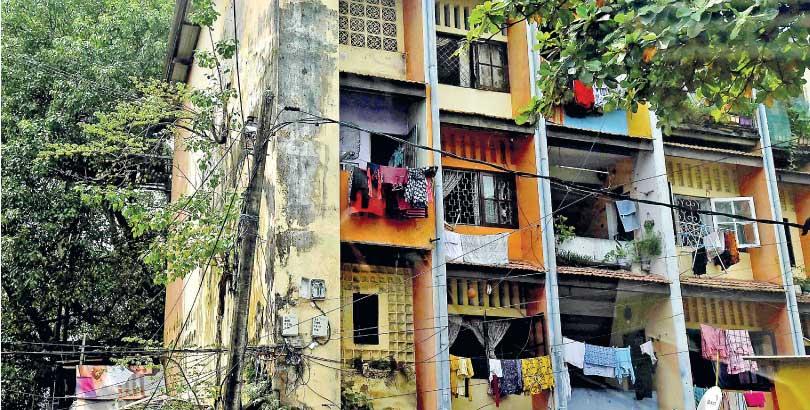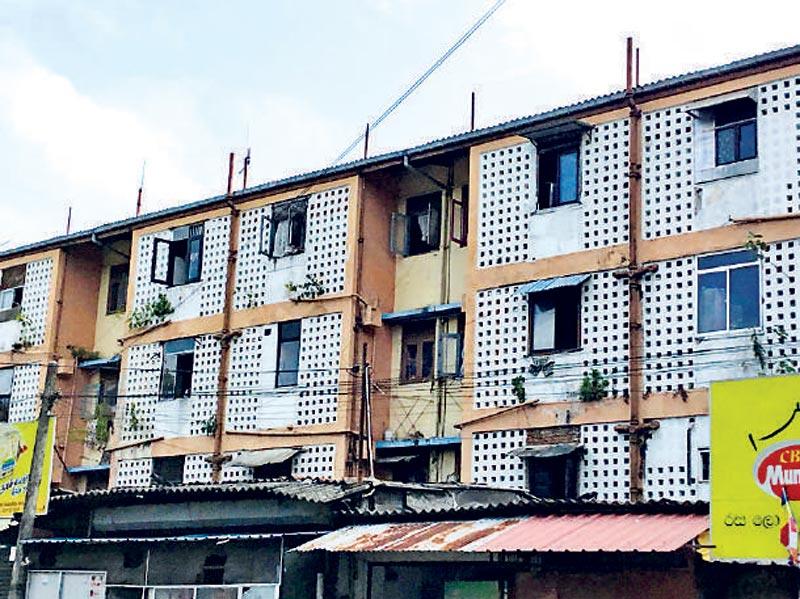Reply To:
Name - Reply Comment

The Wekanda Housing Scheme has been named in a list of housing schemes that have been named recently as unsafe to live in (Pic by Kithsiri de Mel)

Siri Dhamma Mawatha Housing Scheme
 The National Housing Development Authority (NHDA) recently listed at least eight public housing schemes in Colombo as ‘unsafe’ for residents. Although the majority of these housing schemes had been condemned some time ago, residents claim that resettling in another location would deprive them of their livelihoods.
The National Housing Development Authority (NHDA) recently listed at least eight public housing schemes in Colombo as ‘unsafe’ for residents. Although the majority of these housing schemes had been condemned some time ago, residents claim that resettling in another location would deprive them of their livelihoods.
Housing scheme boom post 1970s
Many public housing schemes in Colombo were constructed after 1973 when Sri Lanka Communist Party politician Pieter Keuneman held a cabinet portfolio as Minister of Housing and Local Government.
Some of the major public housing projects in Colombo include the Bambalapitiya Flats, Police Flats in Thimbirigasyaya, Anderson Gold Links (Narahenpita), Maligawatta and Soysapura. Although they were built to provide shelter to the lower income groups in Colombo, successive governments often neglected their maintenance. As a result, many of these housing schemes lack basic amenities such as running water and proper toilets, the stairways and corridors have been neglected and remain dark, elevators are most often under repair, the sewage systems have been blocked and there’s less space for a larger family to live in one housing unit.
Neglected lives
The Wekanda Housing Scheme, Bambalapitiya Flats, Prince of Wales Mawatha housing scheme, Siri Dhamma Mawatha housing scheme, Kamkarupura housing scheme, B36 Maligawatta housing scheme and its G, H, J, K, M, N blocks and the Mihindu Mawatha housing scheme are the establishments that have recently been listed as unsafe. Susantha Botheju, a resident of Kamkarupura Housing Scheme, said that this housing scheme was reconstructed after about 50 years when Wimal Weerawansa held the ministerial portfolio of Minister of Housing. “But people now live in dire conditions. A family of four can barely fit into a housing unit. The sewage system has been blocked at a time when dengue cases are on the rise once again. Do we deserve to be neglected in this manner? Is it because we are in low income segments,” questioned Botheju.
|
- Susantha Botheju, A resident of Kamkarupura Housing Scheme |
The public housing scheme along Siri Dhamma Mawatha too has been listed as unsafe. One of the residents who spoke on conditions of anonymity said that many original owners have rented out their housing units and only come to collect the rent once a month. “Therefore they don’t care if these housing units are either painted or not or whether there is electricity or not. They only care about their rent. We know that we live in a condemned housing scheme and we have tried many times to get together with the rest of the community and pool in money for maintenance purposes. But these attempts haven’t been successful,” the resident added.
Safety; the least of concerns for residents
One of the high risk housing schemes is the Wekanda Housing Scheme located in Slave Island. Even though residents have been notified about the unsafe conditions in which they are living in, authorities claim that they don’t take heed of these warnings. “They forcibly remain in these flats even though we have provided them with an alternative already. They are not concerned about their safety,” claimed
K. A Janaka General Manager at NHDA. “We have already launched an investigation with regards to these condemned housing schemes. It is not feasible to demolish them and reconstruct high rise buildings. Therefore we are following due process at present.”
|
- K. A Janaka General Manager NHDA |
Another stakeholder connected with this housing scheme is Condominium Management Authority (CMA). CMA is the management corporation that oversees the administration of the condominium property. “According to the Condominium Management Authority Act No. 10 of 1973 if a public housing scheme exceeds 40 years, it can be redeveloped,” said Sarana Karunaratne, Chairman of the Condominium Management Authority. “This is the legal provision, but it is compulsory only where necessary. Under the Samagi Peramuna Government the Kamkarupura Housing Scheme, Samagipura housing project, Central Colombo Suriyamalpura housing scheme and several other projects were launched.
|
- Sarana Karunaratne Condominium Management Authority Chairman |
|
Plants dominating the walls of the Kamkarupura Housing Scheme |
The Common Amenity Authority was later converted as the CMA in 2003. The Torrington housing scheme for example was built around 1938. But the problem at the Wekanda housing scheme is that its main beam has burst. Therefore 114 families have to be resettled immediately and we have relocated 57 families at a new location in Henamulla. Since the remaining families are reluctant to leave we have issued ejectment notices as a last resort. With regards to the Prince of Wales housing scheme, the small boutique owners at the entrance to the scheme are reluctant to relocate,” said Karunaratne.
Karunaratne further said that it is the responsibility of the residents to maintain their properties. “The state doesn’t have funds to carry out maintenance activities in these housing schemes. But we remove plants that have sprung out of broken pipes and walls as CSR initiatives. However, there’s a limit for the authorities as well. One other issue is that many residents thrive on smuggling and other petty ‘businesses’. So they don’t want to disconnect from their networks. In fact these are safe houses for people who run the underworld etc. But going forward we are now in the process of obtaining technical reports on each housing scheme from the National Building Research Organisation (NBRO) so that we know their actual status. One of the recommendations is to ink public private partnerships where the developer will provide adequate compensation for the residents and they can ultimately shift to a vertical living culture,” he explained.
But residents at the Wekanda public housing scheme complain of difficulties. They not only find it a challenge to send their children to school, but also find it difficult to engage in their livelihoods from their new location. “These families are from low and middle income groups and they cannot afford to pay additional money for a school van and send their children to school,” said ****M. I. M Anas, an area resident. “On the other hand they (residents) have been doing their permanent businesses in and around Slave Island for a long time. How can they shift their businesses to a new location all of a sudden” he questioned.
The NHDA website further states, ‘Generally, after a housing complex is built and handed over to the residents, they are properly maintained and run by a legal structure consisting of the respective residents called the management corporation. Failure of the management corporation to properly maintain the common facilities of the apartment complex has left the apartment complex in a dilapidated condition.’
|
- M. I. M Anas Resident Wekanda Public Housing Scheme |